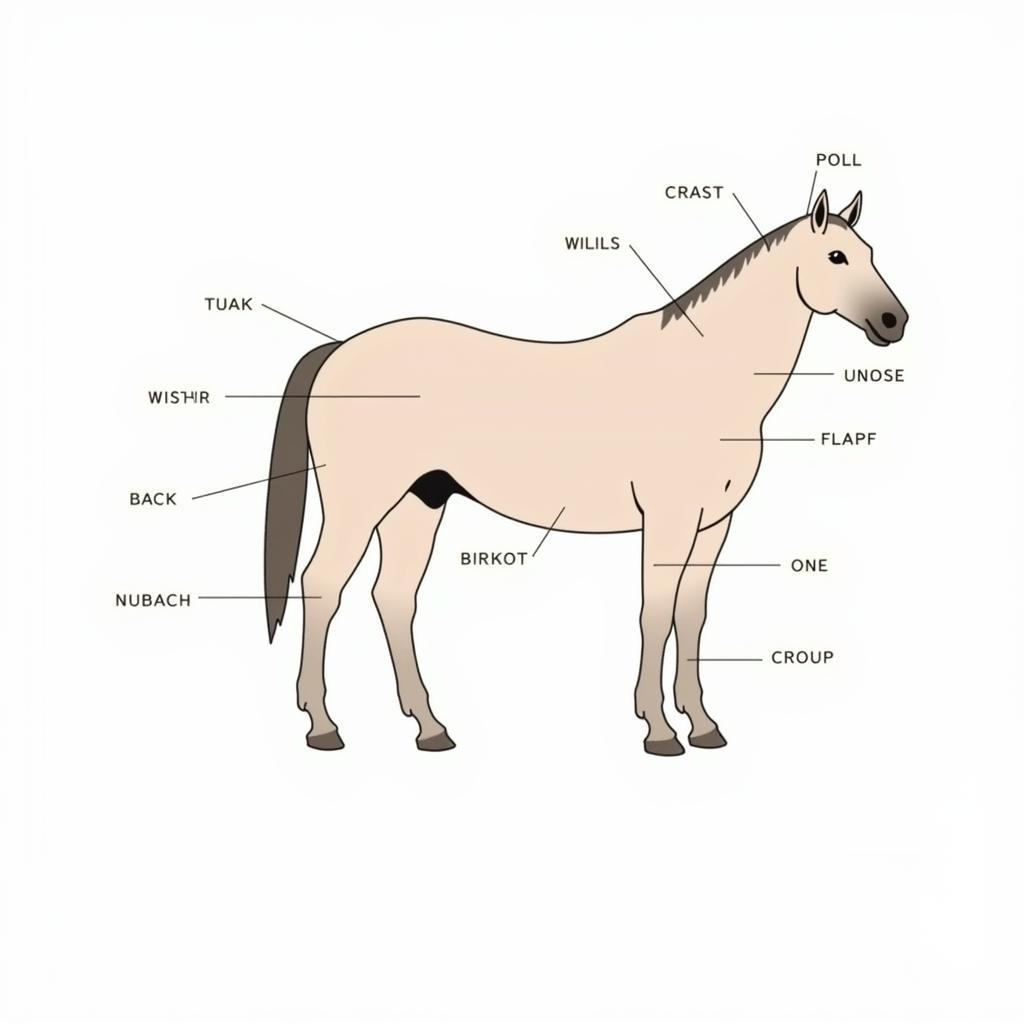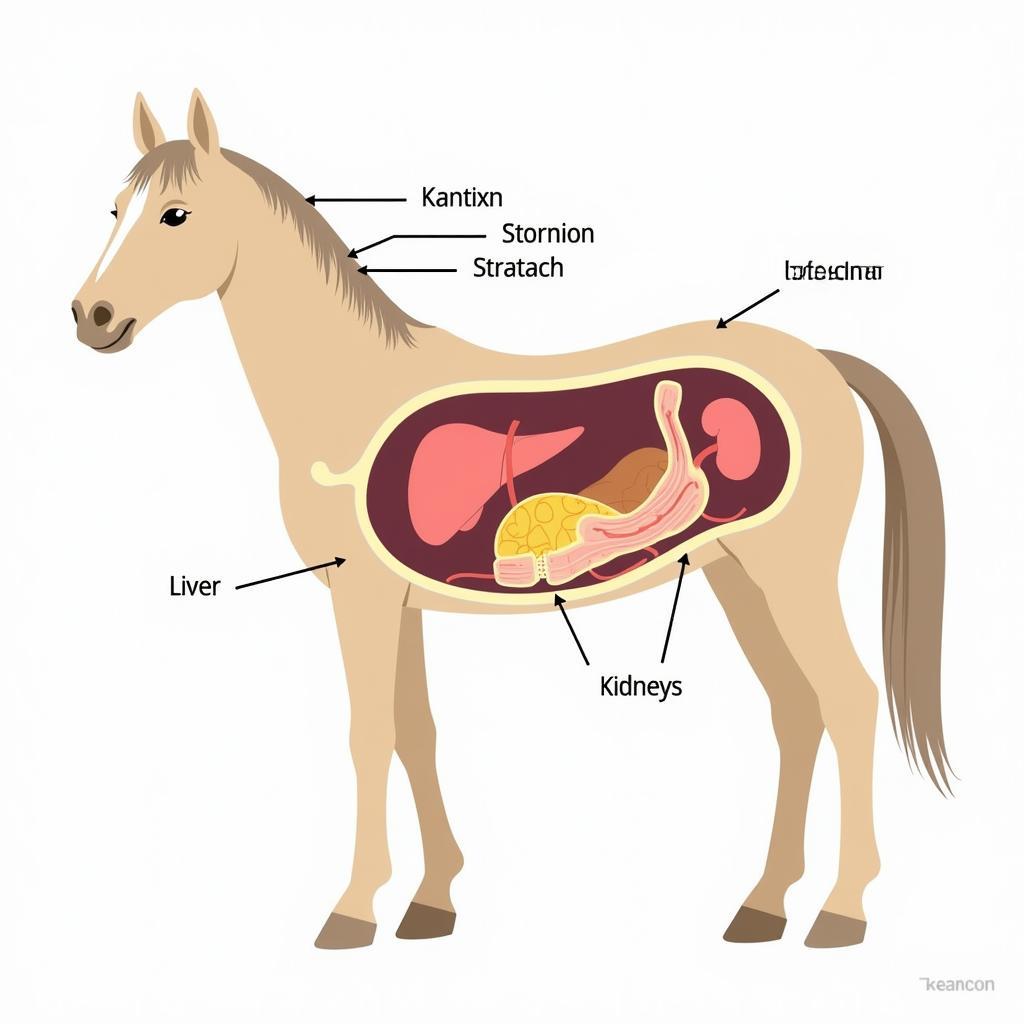A Horse Diagram Labeled is an essential tool for any horse lover, owner, or veterinarian. Whether you’re learning the basics of horse anatomy, studying for an exam, or simply want a better understanding of your equine companion, a detailed diagram provides valuable insight. In this comprehensive guide, we’ll delve into the intricacies of horse diagrams, exploring the different types available and the valuable information they provide.
Navigating the Equine Anatomy: The Importance of a Horse Diagram Labeled
A clearly labeled horse diagram acts as a roadmap to understanding the complex structure of this magnificent animal. From the skeletal system to the muscular system and beyond, these diagrams unlock a wealth of knowledge. They are indispensable for identifying specific bones, muscles, and organs, enhancing your overall horse knowledge. Let’s consider a few scenarios where having a horse diagram labeled would be invaluable. Imagine trying to understand the nuances of equine lameness without a visual representation of the leg’s intricate structure. A labeled diagram allows you to pinpoint the affected area, facilitating communication with your veterinarian. Similarly, when studying equine biomechanics, a detailed horse diagram labeled with muscle groups can bring the subject to life.
 External Horse Anatomy Diagram Labeled
External Horse Anatomy Diagram Labeled
Delving Deeper: Different Types of Horse Diagrams Labeled
Several types of horse diagrams labeled cater to different needs. Some diagrams focus solely on the skeleton, showcasing the intricate framework that supports the horse’s body. Others highlight the complex muscular system, revealing the power and grace behind every movement. Still others map out the internal organs, illustrating the complex processes that keep the horse functioning. For a beginner, a basic horse diagram labeled with external parts is a great starting point. More advanced diagrams might illustrate specific systems, such as the digestive or respiratory system, in greater detail. No matter your level of expertise, there’s a horse diagram labeled to suit your needs.
Exploring the Skeletal System: The Foundation of the Horse
The horse skeleton is a marvel of engineering, providing strength, flexibility, and support. A labeled skeletal diagram allows you to identify each bone, from the skull to the phalanges (toe bones). Understanding the skeletal structure is crucial for recognizing potential issues like fractures or arthritis. It’s also essential for understanding how the horse moves and performs. printable parts of the horse worksheet can be a helpful tool to test your knowledge and reinforce learning.
Unraveling the Muscular System: The Engine of Movement
The muscular system is what powers the horse’s impressive athletic abilities. A horse diagram labeled with muscles can help you understand how different muscle groups work together to produce movement, from a gentle walk to a powerful gallop. This knowledge is invaluable for trainers, riders, and anyone interested in equine biomechanics. Recognizing the location and function of each muscle is also crucial for diagnosing and treating muscular injuries. Resources like a horse muscles diagram can provide a more in-depth look at the muscular system.
Understanding the Internal Systems: A Deeper Dive
Beyond the bones and muscles, a horse diagram labeled with internal organs offers a fascinating glimpse into the complex workings of the horse’s body. These diagrams illustrate the location and function of vital organs like the heart, lungs, stomach, and intestines. Understanding these systems is crucial for recognizing signs of illness and maintaining your horse’s overall health.
Horse Diagram Labeled: A Valuable Resource for All
Whether you are a seasoned equestrian or a beginner, a horse diagram labeled is an invaluable resource. It provides a visual representation of the horse’s anatomy, enhancing your understanding of this magnificent animal. From identifying specific bones and muscles to understanding the complex internal systems, a well-labeled diagram is an essential tool for any horse lover.
 Horse Internal Organs Diagram Labeled
Horse Internal Organs Diagram Labeled
Conclusion: Embracing the Power of Visual Learning with a Horse Diagram Labeled
A horse diagram labeled provides a powerful visual learning tool, allowing you to delve into the intricate world of equine anatomy. From the skeletal framework to the muscular engine and the vital internal organs, these diagrams offer a comprehensive understanding of the horse’s complex structure. By embracing the power of visual learning, you can deepen your appreciation for these magnificent creatures and provide them with the best possible care. Remember, a wheel horse mower deck parts diagram might not help you understand a horse, but a properly labeled horse diagram will!
FAQ
- What are the different types of horse diagrams labeled?
- Why is it important to understand horse anatomy?
- How can a horse diagram labeled help with training?
- What are some good resources for finding accurate horse diagrams?
- How can I use a horse diagram to better understand my horse’s health?
- Where can I find a troy bilt big red horse tiller parts diagram?
- What are some fun activities related to horses, like a paint by numbers horse?
Common Situations Where a Horse Diagram is Helpful:
- Identifying a potential injury.
- Explaining lameness to a veterinarian.
- Learning about equine massage techniques.
- Studying for a veterinary exam.
- Teaching children about horse anatomy.
Other Helpful Resources on Justus Horses USA:
- Articles on horse care and training
- Breed information and guides
- Product reviews and recommendations
Contact us for support: Phone: 0772127271, Email: [email protected], Address: QGM2+WX2, Vị Trung, Vị Thuỷ, Hậu Giang, Việt Nam. We have a 24/7 customer service team.